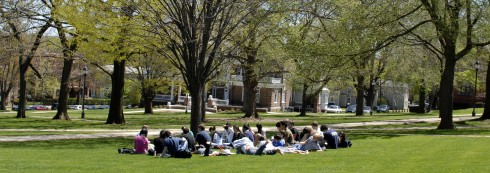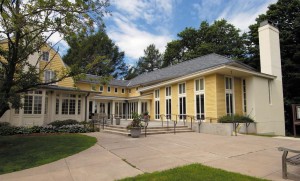Applications Up By 6 Percent Over Record Year

This year, 10,645 seniors from around the world applied to Wesleyan University, an increase of 6 percent from 2009, which was a record year for applications, despite the sour economy.
“Last year we reached an all-time high for applications, up by 22 percent, and this year is 6 percent over that,” says Greg Pyke, senior associate dean of admission.
Of these students, 41 percent are male and 59 percent are female.
The applicant pool contains 362 candidates for the Freeman Asian Scholars program, 860 for early decision admission and 9,423 applications in the regular review process. Two-hundred-and-twenty-nine of these students are alumni sons and daughters.
Nancy Meislahn, dean of admission and financial aid, is encouraged by the increase in “markets that Wesleyan has identified as high potential and priority for recruitment initiatives.” These include African-American applicants, applicants from the South, Midwest (and in particular, increases from Texas, Virginia and Illinois) and international applicants (with marked increases from India and China). Applications from Texas have tripled in the past three years, Meislahn noted.
Compared to 2008 data, this year Wesleyan received 203 more applications from the Midwest, 266 more applications from the South and 619 from the West. Applicants from the Northeast increased by 392 since 2008.

So, why are so many more people applying to Wesleyan? According to a Jan. 29 blog on “Admission and Recognition” by Wesleyan President Michael Roth, it isn’t easy to point to any specific factors with confidence.
“Clearly, we have benefitted from positive press thanks to the great work of our faculty, students, staff and alumni. Our admissions and communications departments have been in high gear making sure that we get the word out about what makes Wesleyan an extraordinary institution,” Roth wrote. “The campus looks great, and investments in our physical plant have had compelling results. We have been emphasizing some of the distinctive aspects of a Wes education, and above all, students and their families have been talking to others about their own experiences.”
Twenty-two percent of the Class of 2014 applicants hail from New England; 20 percent are from New York; 13 percent are from the mid-Atlantic; 7 percent are from the Midwest; 7 percent are from the south; 19 percent are from the west; and 13 percent are from elsewhere in the United States. Twelve percent of the applicants are international.
The applicants come from diverse racial backgrounds. Eleven percent of applicants are Asian or Asian-American, 8 percent are black or African-American, 8 percent are Latino or Hispanic and 1.2 percent, or 125 students are Native American. Sixteen Native Hawaiians also applied to Wesleyan this year.
Roth says there’s no need to “sell Wesleyan,” or “develop some slick marketing messages. After all, by emphasizing our distinctiveness we are also saying that Wes isn’t for everybody. The culture of openness and experimentation, exuberance and achievement, creativity and focus…this culture is different from the ones that have developed at other fine schools. We want to get the word out, but we don’t need to present ourselves as just another highly selective school for successful high school seniors.”
Of the 10,645 applicants approximately 745 are expected to join the Class of 2014. Sixty-three percent of the applicants, including Freeman Scholars, applied for financial aid.
The median ACT score for the applicant pool is 31 and the median SAT scores are 690 for critical reading and 690 for math. About 25 percent of applicants are sending ACT scores, Meislahn reports.
“Now that we have well over 10,000 applications for next year’s class, the admissions staff has to read each one of them with the time consuming care that comes with a holistic application process,” Roth says. “I thank them in advance for all the hard work that will go into putting together the class of 2014!”

